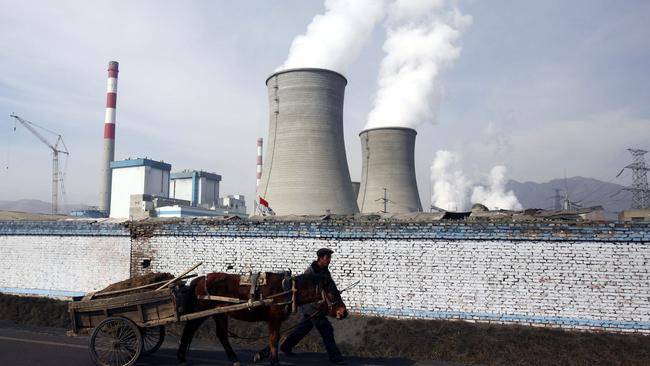Four Pillars: Capital flight from coal

The move last Friday by the world’s fifth biggest lender with $US2.61 trillion ($3.6 trillion) in assets is a globally significant decarbonisation development.
Given that failure to implement Xi’s thoughts is career suicide, perhaps the biggest surprise is that Bank of China waited a couple of days to take action.
The ramifications for the coal industry are huge, particularly if similar commitments are made by the country’s other commercial banks.
Already, the big four banks in Australia have promised to exit thermal coal by 2030, with individual exposures trimmed to the hundreds of millions of dollars as they decarbonise their lending portfolios.
Bank of China, for its part, is a top global investor in coal-fired power plants, funding more than $US35bn of coal-based projects since the Paris climate agreement in 2015.
Chinese public and commercial institutions reportedly financed 13 per cent of total coal-fired power capacity – equivalent to 68.8GW – that was operating, under construction or planned outside China between 2013 and 2019.
In Australia, billionaire Clive Palmer was dreaming if he thought his plan for a 1400MW coal-fired power station in central Queensland – fed by four million tonnes of product a year from his proposed Galilee coal project – would proceed.
But now, the odds are minimal at best, if not closed off entirely.
Tim Buckley, a former Citigroup head of equities research who is now director of energy finance studies at the Institute for Energy Economics and Financial Analysis, says the prospect of the Palmer project attracting debt, equity or insurance was extremely low.
“But now it’s close to zero as a result of the Bank of China announcement,” Buckley says.
Kevin Gallagher, director of the Global Development Policy Centre at Boston University, tweeted that if President Xi’s pledge included China’s commercial banks, that would be much more ambitious than anything the west has done to contain global warming.
“Citigroup/JPMorgan/Bank of America/Barclays time to follow suit,” Gallagher said.
The dramatic turnaround in the outlook for the coal industry as the world decarbonises means we are at the beginning of the end for the high-emitting industry.
The only argument is about the long-term trajectory.
NSW, which is the most exposed state government in the world to thermal coal and the decarbonisation of the power sector, has effectively recognised this.
Most of the coal dug up in the state is exported, which makes the future of the industry dependent on global demand.
In 2020, the three top markets for NSW coal – Japan, South Korea and China – all announced their intention to achieve net zero emissions by the middle of the century.
In its 2016 intergenerational report, NSW Treasury forecast 1.2 per cent in annual volume growth for four decades until 2056.
Five years later, the prognosis dramatically changed, with the updated report accepting that global demand for coal would weaken “considerably”.
A scenario predicated on lower demand concluded that coal volumes would plunge to zero by 2042, or more than halve under the more conservative reference scenario by the mid-2040s.
The deteriorating outlook for coal will have a significant impact on employment and the NSW budget.
Coal royalties contributed $1.5bn to the budget in 2019-20.
With ground-shifting developments like the Bank of China announcement last Friday, the intergenerational report’s lower demand scenario should now be the base case.
–
Customer rules
The customer is everything in banking, with the capacity to slice and dice data for meaningful insights not too far behind.
On Friday, National Australia Bank’s former head of Bank of New Zealand, Angela Mentis, will start her new role as group chief, digital, data and analytics officer, reporting to CEO Ross McEwan.
Since the announcement of Mentis’ new role last month, she and chief technology officer Patrick Wright have poached Christian Nelisson from the Commonwealth Bank to fill the same role of chief data officer that he held at CBA.
Nelisson has worked extensively in the offshore banking industry, including a stint leading the data and analytics function at the Royal Bank of Scotland, where McEwan was chief executive.
McEwan said in August that Mentis would work across NAB to deliver digital products and services, ensuring that the data collected by the bank was used to create better customer experiences and deeper personalisation.
“Customer expectations continue to rise as competition drives innovation,” he said.
“That means we need to be delivering a digital experience for our personal and business customers that compares with the best experiences they have with any company, not just a bank.”

Announcing the Mentis appointment internally, the NAB chief told staff he wanted the bank to “move much faster”, and that among her priorities Mentis would help to ensure NAB got the full potential of data-sharing from the open banking revolution.
Like with the skills shortage in financial crime, the major banks are all competing in the employment market for data, digital and engineering experts.
NAB is seeking hundreds of people with the relevant expertise.
Mentis’ replacement in NZ is Dan Huggins, who is currently BNZ executive, customer, products and services.
gluyasr@theaustralian.com.au
Twitter: @Gluyasr

The flight of global capital from the coal industry is accelerating, with the Bank of China faithfully enacting President Xi Jinping’s pledge to the United Nations that China would stop funding coal-fired power plants offshore.